
The Wizcom ReadingPen/TS is marketed as “a portable learning tool” aimed at people trying to learn English, how to read, or with reading challenges. The device is basically a text scanner with a text-to-speech capability.
I was able to let an experienced teacher and a speech therapist try it out, as well as playing with it myself.
How’d it do?
The tech specs on this one are a bit more than I would like to include in the article, so click here for a link to them. When you open the box, you find the pen in a rigid plastic, almost presentation-style case (that cannot hold many of the other items). There is an earphone, computer cable (mini-USB to USB), batteries, a CD, a ‘training tip’, and the manual.
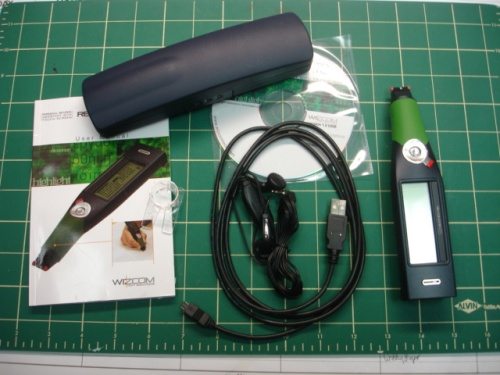
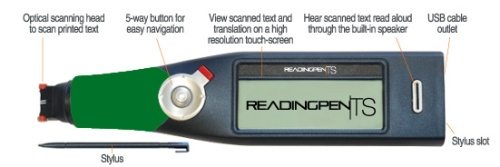
Physically, the large pen-like tool has a reading tip, a small joystick control with power button, and a touch screen. On the back end, there is a headphone jack, mini-USB jack, and the stylus slot. You can use your finger, but the targets on the screen are very small. The headphone jack is useful as the on-board speaker is quiet.
The manual walks you through the set-up and a tutorial quickly. The TS series features a Touch Screen and stylus that allows you to use the tool. The screen menu is largely icon driven, and the icons are not intuitively obvious so the manual helps at first.
Scanning is not bad. The training tip helps you line things up to get you started. Other functions, like connecting the the computer and playing some of the built-in games, etc. are all pretty straightforward.
Scanning quality is… about what you would expect. There are training sentences in the manual that scan and read perfectly, but if you scan other passages, things can get… funny. It does not like icons, borders, unusual punctuation, etc. The word ‘icon’ occasionally gets read as ‘jon’, etc. It sometimes takes a couple passes to get a good scan. The scan head has little wheels to help guide your scan, but if you are not tracking straight it will garble the words as well, especially if it picks up another line of text.
Also note- it does one line at a time. If you pick it up to scan another line, it processes the first line first. This limits it for reading blocks of text and chapter books, or using as a pen scanner.
The speaking voice is synthesized. It is not bad and the pronunciation is usually clear, but it offers an odd ‘accent’ on some words, like ‘of’. You can adjust the volume, pitch, and reading speed to make it better for the user. The built-in speaker is pretty quiet- headphones are recommended, but then it makes it difficult for anyone else to help the user.
It takes some practice to scan properly- you need a straight track, smooth and slow movement, and the right angle at the tip. The ‘training tip’ helps, but it comes pretty quickly with practice. The unit recognizes a wide range of fonts and sizes, although it does have trouble with some ink and paper colors.
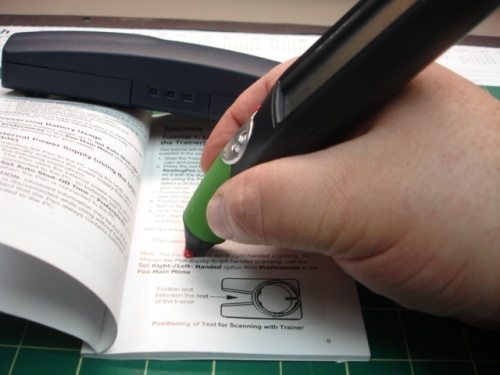
In use, you scan a word or a line, then let it process. It will speak the scanned info and then let you choose between various options- Spanish translations, synonyms, syllables, or definitions. It takes a moment to think after each scan- which gets tedious if you are trying to make it read a longer passage, but is not so much a problem with single words. In fact, most of the features work better with individual words than entire lines.
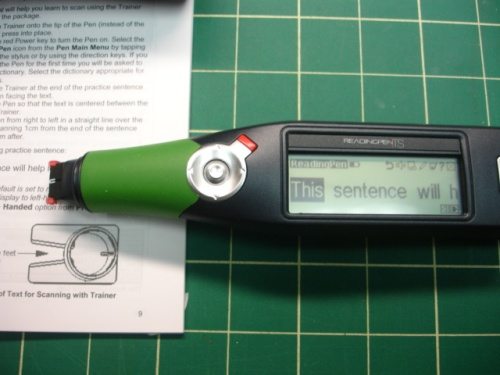
It has several built-in dictionaries and references- it is hard to trip it up and find words it does not recognize… although sometimes it takes a couple tries to get it to read something correctly.
It features several games for helping with vocabulary, the ability to work with an XP/Vista computer for saving scans and words, and a few other helpful features. These are nice features, but neither of my guest testers used them much. The games have a familiar feel to anyone who has used a game with a black and grey screen with big pixels.
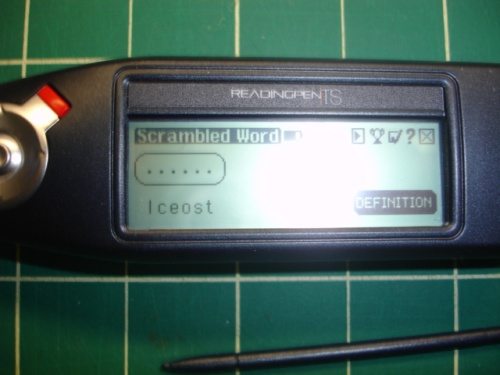
According to my guest testers (a teacher and a speech therapist), the unit works well enough after you get used to it, although both found they needed to use the manual quite often at first to remember what all the icons meant. Both commented that the computerized voice does not always have the best pronunciation or accenting, and both made the comment that ‘it would be helpful for some students, but is not for everyone’.
Both felt that its main strength was in helping with individual words. The teacher felt that using a dictionary correctly might be a more useful skill, while the speech therapist liked that it helped with pronunciation and broke it into syllables when asked, although she was sometimes concerned that the quirks in the computerized voice might interfere with learning proper pronunciation.
One of the strengths of the pen is its portability- it does not need a computer or anything, you can just carry it wherever you need it, and it can even be used on things like signs, posters, menus, etc. as long as the font is the right size and color.
Which leads me to something both testers mentioned. Neither was interested in purchasing the $200 pen to use with their students or clients since many of the things it does can be handled by a cheap dictionary, any of dozens of free on-line sites, or the teacher/therapist themselves.
So who would this tool help? The website states it nicely, describing it as “A portable learning tool designed for students of a second-language as well as for children and adults with reading difficulties (such as dyslexia).” Emphasis on the word ‘portable‘- it would be most helpful (in our opinion) for someone who does not have ready access to other forms of assistance.
ELLIPAL Titan 2.0 Crypto Cold Wallet, 100% Offline, Air-gapped - Secure Wallet for 10000+ Coins & Tokens & NFTs
5% OffESR Upgraded for MagSafe Wallet, 5 Card Holder, RFID Blocking, Magnetic Wallet for iPhone with Adjustable Stand, Slim for iPhone 17/16/15/14/13/12 Series, Not for 13/12 Mini, Vegan Leather, Black
27% OffProduct Information
| Price: | $200 |
| Manufacturer: | Wizcom Text Solutions |
| Pros: |
|
| Cons: |
|



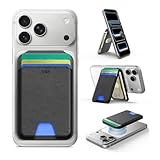
Gadgeteer Comment Policy - Please read before commenting
A number of years ago, my sister suffered a stroke. Her ability to read was impaired. She understood speech just fine — but reading and even speaking was challenging. I picked up one of the ancestors of this gizmo for her.
I have to say, it was very helpful. She was able to adapt fairly quickly and take over her bills and mail again without help. It also allowed her to read the news paper. If there was a part of a sentence she couldn’t understand, just swipe the wand, it reads it out loud and POOF. She understood.
$200 might be a lot for a student, though. But it works as advertised and in this person’s opinion, was designed by angels. I even purchased two more and donated them to the stroke therapy group at my local HX.
Thank you for this great review!! It has been very helpful.
please let me know ,if your pen can translate English text to Farsi language ( Persian ) or if it is possible for you to have this option.
BRGDS Sarlak
The one that was provided only did Spanish to English. If you contact the company, they may be able to help you more.